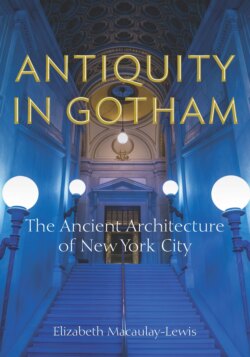Читать книгу Antiquity in Gotham - Elizabeth Macaulay-Lewis - Страница 7
Introduction: From the Appian Way to Broadway
ОглавлениеThis study, Antiquity in Gotham: The Ancient Architecture of New York City, stems from a chance encounter. As the child of an ornithologist, I spent many hours in the storerooms of the American Museum of Natural History, drawing or reading, while my mother photographed and documented bird skins. Since we lived in Connecticut, we would drive into New York City and enter the museum via Columbus Avenue. My childhood memories of the museum are filled with brightly colored, exotic birds, dioramas of cougars about to pounce, skeletons of dinosaurs, and the wondrous universe as experienced at the Hayden Planetarium.
I was therefore struck dumb when I returned to New York City in 2011 after almost a decade abroad: I walked through Central Park toward Manhattan’s West Side to find the Arch of Constantine attached to the façade of the American Museum of Natural History (see Figures 21 and 50). At this moment, as an utterly confused classical archaeologist, I wondered aloud, “Who stuck the Arch of Constantine to the American Museum of Natural History?” Far more sensible New Yorkers walked past, ignoring me as if I were a tourist.
Upon closer inspection, it was evident that a modified version of the Arch of Constantine had actually been affixed to the museum’s west façade. This elaborate arch and its accompanying plaza served as the main entrance to the museum and as the New York State Memorial to Theodore Roosevelt. The now controversial equestrian statue of Roosevelt, accompanied by two highly problematic and racist figures of a Native American and an “African,”1 stood in front of the arch rather than atop it, as such a statue group would have done in ancient Rome. The explorers and naturalists—Lewis, Clark, Audubon, and Boone—took the place of the bound Dacian captives who stood on top of the Corinthian columns on Constantine’s arch. The seals of New York State and New York City replaced the Hadrianic tondi of sacrifices and hunt scenes.
Why on earth did an early fourth-century CE Roman arch, which celebrated Constantine’s victory in a civil war, serve as a model for a commemorative memorial to a beloved American president and famed son of New York? Why did the New York legislature and Henry Fairfield Osborn, the president of the museum, select the arch? Did they know that it was a triumphal arch? Did it matter that it celebrated a victory in a civil war? These questions stayed with me. Soon I started seeing columns, temples, obelisks, and personifications of Victory throughout New York City’s five boroughs. I became more and more puzzled: If the skyscraper was the quintessential New York building, then why was the architecture of imperial Rome, fifth-century BCE Athens, the Hellenistic world, ancient Egypt, and the ancient Near East present on practically every other street corner? Why had ancient architecture been of sustained interest and use to New York’s architects, artists, officials, patrons, and elites throughout the city’s history? Such quandaries led to this project, which investigates why the architecture of classical antiquity, ancient Egypt, and the ancient Near East has been repurposed in the architecture of New York City since the late eighteenth century.
